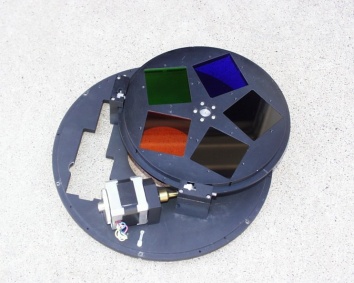UBVRI filters
When using a telescope to make images of celestial objects, astronomers often place special pieces of glass called filters into the path of the light. Just as a coffee filter allows coffee to pass through, and blocks everything that is not coffee, an astronomical filter allows light of certain wavelengths to pass through and blocks other wavelengths. This enables astronomers to study specific colors of light from celestial sources. Astronomical filters are made of colored glass and usually measure about one square inch.
Two important types of filters are wide-band filters and narrow-band filters. Narrow-band filters, as their name suggests, only allow a small range of wavelengths of light to pass through. They are often used to study light that is emitted by specific elements, such as hydrogen or oxygen. Wide-band filters, on the other hand, isolate a large range of wavelengths of light. In the area of the spectrum near visible light, the most commonly used set of wide-band filters go by the names U, B, V, R, and I.
The U filter stands for ultraviolet, and it allows light of wavelengths between about 320 nanometers (nm) and 400 nm to pass through. Thus, the U band is about 100 nm wide.
The B filter is for blue, and it filters light of wavelengths between about 400 nm and 500 nm.
Likewise, the V, R, and I filters stand for visible, red, and infrared respectively, and their respective wavelength ranges are approximately 500 nm to 700 nm for V, 550 nm to 800 nm for R, and 700 nm to 900 nm for I.
The system was first developed in the 1950s at the McDonald Observatory with the 0.9-meter Telescope, and included the UBV filters. Today, the UBVRI filter system has become standard in astronomy. Many astronomers use these filters for a wide variety of research projects.


